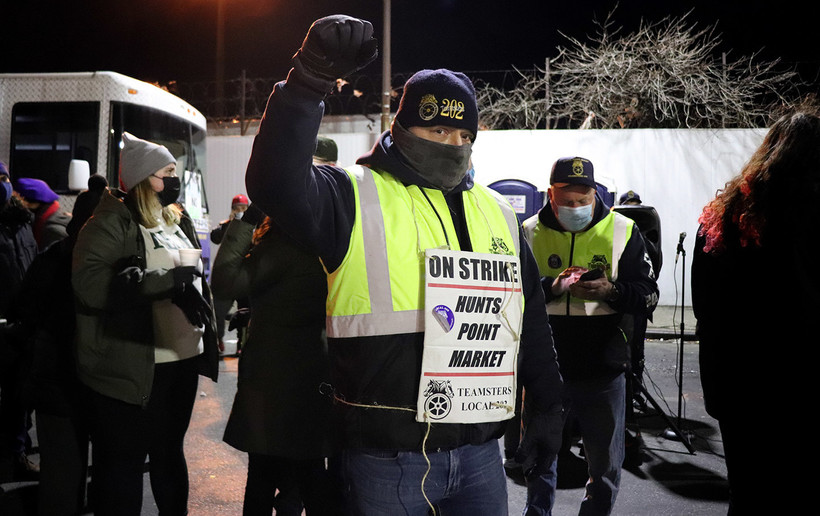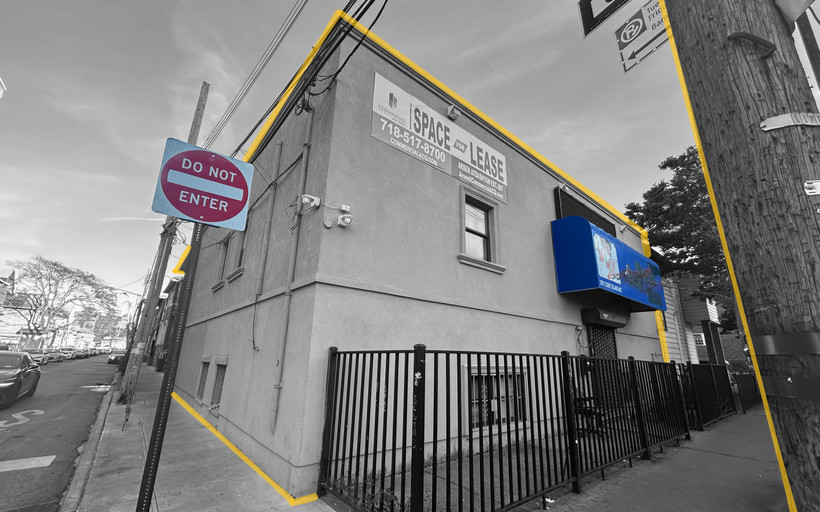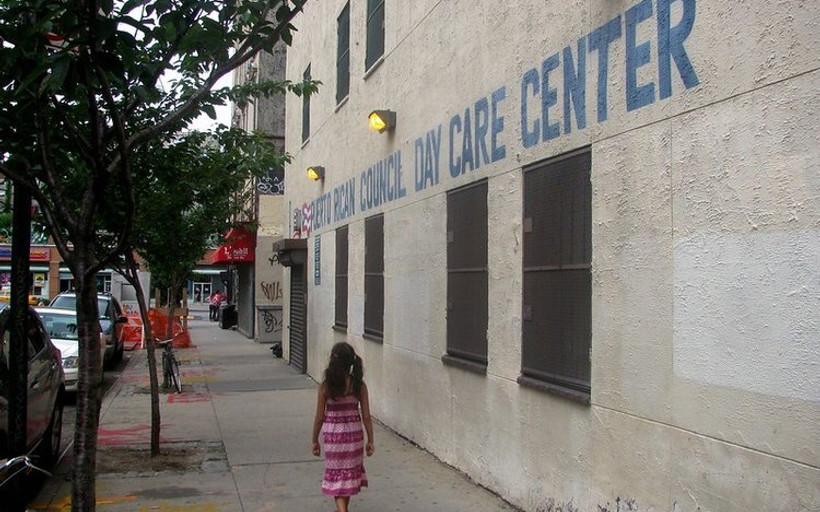Abolish the EDC
The Economic Development Corporation manages city land in the service of private profit. We need a new approach.

This article is published in our Perspectives section, featuring analyses and views by New Yorkers uniquely qualified to weigh in on high-stakes political debates.
In January, workers at the Hunts Point Produce Market went on strike for a one-dollar raise. These were essential workers who had worked through the pandemic’s worst months to supply groceries and restaurants around the city with fresh fruits and vegetables. Their cause attracted widespread sympathy, and high-profile politicians from Andrew Yang to Alexandria Ocasio-Cortez flocked to the picket line to support them.
Mayor Bill de Blasio, however, stayed quiet. The strike put his administration in an awkward position: Hunts Point itself is owned by the city’s Economic Development Corporation (EDC), which leases it to the market’s owners. The local market is usually touted as an economic development victory for the city, providing 3,000 jobs and netting billions of dollars in revenue. This gives the market owners an advantage: they can scare the EDC with the threat of moving to New Jersey or Connecticut. In the last round of lease negotiations in 2013, they extracted a 11% rent reduction from the EDC. Meanwhile, though the EDC boasts of providing jobs and local produce distribution, it has no mechanism for enforcing workers’ rights and no leverage for keeping the market in place long term.
The EDC is the quasi-public agency that manages all revenue-generating land owned by New York City, including Hunts Point. A non-profit organization whose board is appointed by the mayor, the EDC is a multi-purpose tool for City Hall to coordinate private business activity in the city’s interests and pursue a range of projects without the supposed inefficiencies of city agencies. It has the power to arrange subsidies and tax breaks for companies for the sake of job creation. In 2019, these subsidies cost the city $1.6 billion.
But with recent failures and inefficiencies of its own, the EDC is facing increased scrutiny. “The city and state can sustain projects that can support a healthy local economy without supporting bad economic development projects and enormous tax subsidies for corporations, as the EDC does,” State Senator Julia Salazar told us.
Next year's City Council will see dozens of new progressive legislators who won office promising to reclaim the city from the real estate industry. A key part of their agenda should be to cut the city's contract with the EDC and to consolidate its resources and holdings under the direct control of the city government—and for the Left to offer an alternate vision of economic development.
Corporate Welfare
The EDC operates all revenue-generating land owned by the city—66 million square feet of real estate generating $150 million annually. Its portfolio includes the city’s airports, cruise terminals, and a dozen public properties in Times Square, which the state declared “blighted” and acquired through urban renewal powers in the 1980s. The rent from these properties provides most of the EDC’s operating budget, which it frames as “self sustaining.”
In reality, the arrangement allows the EDC to avoid democratic control over what should be public money.
In the past year, it has garnered criticism for using those revenues to heavily subsidize the city’s expensive ferry system. For an agency that prides itself on data driven policies and technical expertise, ferries have proven a surprising excess — the EDC closed out 2019 with an operating loss of $1.8 million due to ferry expenditures.
The EDC owns the land under its properties, some of which it leases to luxury hotels and large firms like Disney. Rather than assessing conventional property taxes on these properties, it collects Payments in Lieu of Taxes (PILOTs). These arrangements allow increases in value past a certain threshold to be captured solely by the lessee; not only do they allow the EDC to capture public funds before they can be democratically managed, but they also allow already wealthy lessees to underpay the city for valuable property. The lessees enjoy rapidly rising values, but the city only sees a flat annual payment, while locals are left with higher costs of living.
The EDC uses its immense powers and subsidies in the name of job creation—but it’s unclear how many jobs it actually creates. At a 2019 City Council hearing, then-Councilmember Ritchie Torres skewered then EDC CEO James Patchett for the corporation’s anemic progress on the de Blasio administration’s marquee jobs program.
“Anyone who heard the mayor’s [2017] State of the City would believe there are actual jobs...but anyone who believes that is operating under a false assumption,” Torres said.
While promising 100,000 good-paying jobs, EDC could only claim credit for 3,000 — which took $300 million in public spending to create.
The vast subsidies the EDC doles out to private firms leave the city a hostage to those very subsidized firms: they can always threaten to leave when their contract or lease is up, leaving the city no better off. Meanwhile, firms can always slash jobs, with only nominal fines.
Pfizer, for instance, took in $46 million from the EDC in 2003 as encouragement to stay in the city. In 2010, it returned $24.7 million after slashing its workforce. This left the company with over $21 million in city benefits, even though it had eliminated more than a thousand jobs and, according to an executive, never planned to leave the city in the first place.
The EDC’s theory of job creation is intentionally vague and unscientific. Peruse the cost-benefit analyses that justify the public expenditures of subsidies and tax breaks, and you will find benefit estimates padded by “induced” and “indirect” benefits—namely, the general positive economic consequences of more people having jobs. But there is no effort to compare those numbers to realistic alternative uses of the foregone revenue; the analyses don’t factor what the city could have done with the tax revenue it forgoes.
For example, in 2012, the EDC contributed $81 million to move a Fresh Direct warehouse from one borough of New York City to another—then claimed credit for the benefits generated by those warehouse jobs.
“Often, when it comes to these subsidies, we’re told that we’re not spending a dime. It’s always the subtext of, ‘manna from heaven, we should be grateful!’” said Greg LeRoy, Executive Director of Good Jobs First, a group which tracks economic subsidies. “But that’s nonsense.”
The EDC’s theory of development is a version of the Keynesian multiplier effect, which suggests that the more the government invests in the economy, the more the effects will multiply across the economy. But in classic Keynesianism, the multiplier effect starts with the government actually providing jobs. The government hires workers to, say, build a dam, and then the workers spend their wages, supporting businesses and strengthening the economy.
In the EDC’s theory, the multiplier effect starts with the government giving money (or cheap land) to businesses. These businesses then make vague and unenforceable promises to do some hiring. But many of the greatest beneficiaries of city economic subsidies, such as the New York Yankees, or Fresh Direct, are far from major providers of living wage jobs. Other beneficiaries, like Pfizer, can simply drop their workers when they no longer serve the bottom line.
If the goal of the EDC were indeed to stimulate the economy, why not simply directly employ workers and leave unreliable private businesses out of the equation?
Beyond jobs, the EDC justifies itself as an investment in the city’s future, spurring growth and thus expanding future tax revenue. According to the NYC Department of Finance, real estate tax abatements cost the city $440 million in lost property taxes in 2020 alone. Mayors and City Council members have historically defended tax abatements like these, arguing that they enable the city to capture property taxes on inflated real estate values later on. The tax abatements resemble a snake eating its own tail—revenue is forfeited today for a tomorrow that never comes.
In addition to subsidizing wealthy corporations and inflating property values, the EDC functions as a major contributor to gentrification and inequality in one more way: by facilitating rezonings, which have exacerbated the land values and rising inequality fueling gentrification over the past two decades. Technically, rezonings are handled by the Department of City Planning (DCP). But over the last two decades, the EDC has played a major role in coordinating them with developers, who have overwhelmingly benefitted from this arrangement.
“A lot of what the EDC does is basically be a cheerleader for land use proposals that are bad,” Salazar said. One of the most contentious proposals was the rezoning for the Bedford Union Armory, in which EDC gave away public land to a private developer in the rapidly gentrifying neighborhood of Crown Heights against vocal community opposition.
A Path Forward
After the recent primary elections and in the wake of the coronavirus-induced recession, the future of the city’s economy is up for grabs. The Left should seize the moment and offer a vision that prioritizes economic development through more democratic forms of public investment, creating social return on investment for the most vulnerable in our city. At a minimum, this means restructuring economic development energy away from real estate firms and towards community institutions.
“I don't see any reason why we can't do a radically different approach to economic development to the state so that corporations are not receiving any public funds,” Salazar said.
As the Left begins to amass power in New York City, it must reckon with how it will engage with the EDC and its immense powers. To start, we could redirect funds from corporate welfare to deliver relief to New York City Housing Authority (NYCHA) residents who need it most. We shouldn’t have to rely on rezonings and gentrification to raise funds for public housing. But in the long term, we should seek to abolish the EDC and establish more democratic forms of deciding what gets developed and how the public pays for it.
This moment is ripe for investing in the people and city of New York. In its social-democratic heyday, the city strengthened its economy by providing good housing and high-quality education. Instead of funneling money to developers who make our cities unaffordable or unreliable employers, we could return to those priorities and create a city affordable and livable for working people. That would be real economic development.
Avi Garelick is a student of urban planning at Hunter College and a community organizer based in Washington Heights. Andrew Schustek is an urban policy graduate student, researcher, and writer in New York City.



